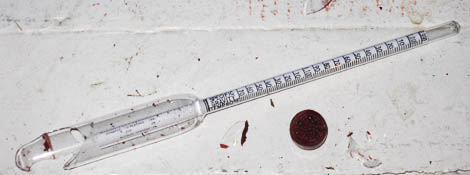 Well, it was bound to happen eventually.
Well, it was bound to happen eventually.
That picture is of my very first (and only) hydrometer. I got that in the starter kit I bought over five years ago, when I began this long and crazy descent into brewing madness. Over the years, I’ve treated this thing with kid gloves – especially as the time and brew sessions kept adding up. “How cool would it be,” I mused, “to still have that original hydrometer, that connection to my humble beginnings, forever?”
I had planned to eventually retire it, perhaps mount it and hang it over that bar I’m going to build one day. I daydreamed about its last task being the measurement of my first professional wort’s gravity. It served me very well throughout the years, and today, it is no more.
My dear wife accidentally dropped it today when she was helping me clean up some of my brew gear. She feels horrible about it – she knows how much that hydrometer meant to me – and she’s keeping the pieces to make some sort of tribute or memorial to my trusty friend. Perhaps it will still find its rightful place in my personal brewing museum, as time keeps marching on and I try and make this less of a hobby and more of a profession.
However, as I think about it, I can’t be that sad. After all, it’s just a hydrometer – an easily replaceable tool, and one which I have been considering replacing with a refractometer for some time now anyway. When I stop and think about what’s really valuable, what’s been with me since the very beginnings of my brewing journey and what has always encouraged and supported this passion of mine, it’s my wife.
She took me to my first brewery tour at Harpoon in Boston, and we brewed our first beer together. She came with me to pick up the kit, to learn how to use that tricky hydrometer for the first time, and to drink that brew which was the best beer I’d ever had because I had made it myself. And she has put up with the never-ending array of gadgets, freezers, buckets, and CO2 tanks which have taken over our home. She encourages and inspires me, and I truly think that helps me brew better beer more than any tool could.
So, rest in peace, hydrometer. You served me well, and you will not be forgotten. I raise a glass to you tonight – to brews of the past, and the brews of the future you will not be there to measure. However, I shall not be sad, for I still have the really important things in life, and to lose sight of that would be the real tragedy here.
 The good news: I now have ten gallons of Kölsch fermenting in my chest freezer (which just BARELY fits two 6.5G plastic buckets inside).
The good news: I now have ten gallons of Kölsch fermenting in my chest freezer (which just BARELY fits two 6.5G plastic buckets inside).